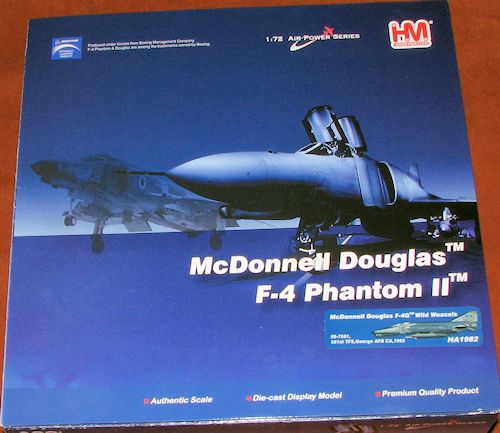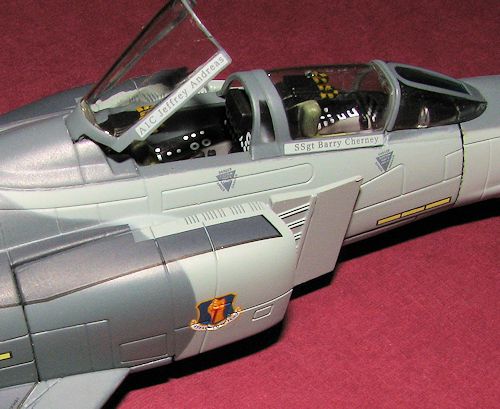
Hobby Master Ltd 1/72 F-4G Wild Weasel
| KIT #: | HA1982 |
| PRICE: | $70-75.00 range |
| DECALS: | Pre-painted |
| REVIEWER: | Scott Van Aken |
| NOTES: | Die-Cast kit |

| HISTORY |
The McDonnell Douglas F-4 Phantom II is a tandem, two-seat, twin-engine, all-weather, long-range supersonic jet interceptor fighter/fighter-bomber originally developed for the United States Navy by McDonnell Aircraft. It first entered service in 1960 with the U.S. Navy. Proving highly adaptable, it was also adopted by the U.S. Marine Corps and the U.S. Air Force, and by the mid-1960s had become a major part of their respective air wings.
The Phantom is a large fighter with a top speed of over Mach 2.2. It can carry over 18,000 pounds (8,400 kg) of weapons on nine external hardpoints, including air-to-air missiles, air-to-ground missiles, and various bombs. The F-4, like other interceptors of its time, was designed without an internal cannon. Later models incorporated a M61 Vulcan rotary cannon. Beginning in 1959 it set 15 world records for in-flight performance, including an absolute speed record, and an absolute altitude record.
During the Vietnam War the F-4 was used extensively; it served as the principal air superiority fighter for both the Navy and Air Force, and became important in the ground-attack and reconnaissance roles late in the war. The Phantom has the distinction of being the last U.S. fighter flown to attain ace status in the 20th century. During the Vietnam War the USAF had one pilot and two weapon systems officers (WSOs), and the US Navy one pilot and one radar intercept officer (RIO), achieve five aerial kills against other enemy fighter aircraft and become aces in air-to-air combat. The F-4 continued to form a major part of U.S. military air power throughout the 1970s and 1980s, being gradually replaced by more modern aircraft such as the F-15 Eagle and F-16 in the U.S. Air Force; the Grumman F-14 Tomcat and F/A-18 Hornet in the U.S. Navy; and the F/A-18 in the U.S. Marine Corps.
The F-4 Phantom II remained in use by the U.S. in the reconnaissance and Wild Weasel (suppression of enemy air defenses) roles in the 1991 Gulf War, finally leaving service in 1996. It was also the only aircraft used by both U.S. flight demonstration teams: the USAF Thunderbirds (F-4E) and the US Navy Blue Angels (F-4J).[ The F-4 was also operated by the armed forces of 11 other nations. Israeli Phantoms saw extensive combat in several Arab–Israeli conflicts, while Iran used its large fleet of Phantoms in the Iran–Iraq War. Phantoms remain in front line service with several countries, and in use as an unmanned target in the U.S. Air Force. However, it is soon to be replaced in the drone force by the QF-16C as the diminishing number of Phantom airframes is used up. Phantom production ran from 1958 to 1981, with a total of 5,195 built, making it the most numerous American supersonic military aircraft.
As a note, the F-4G aircraft were all converted F-4Es in the 69-xxxx serial sequence and was also the last combat Phantom variant flown by the regular USAF and ANG. Most if not all of them are and will be expended as drones.
| THE KIT |
 Last year I was contacted by Hobby Master regarding some information about a specific aircraft, F-4G 69-7561, which just happened to be the boss bird for the 561st TFG in 1992. I was able to supply images that included the names on both sides of the canopy rails, something Hobby Master was quite interested in getting to assure accuracy. They stated that they'd send me a copy of the kit when it was released and a few days ago, a package arrived with this airplane in it.
Last year I was contacted by Hobby Master regarding some information about a specific aircraft, F-4G 69-7561, which just happened to be the boss bird for the 561st TFG in 1992. I was able to supply images that included the names on both sides of the canopy rails, something Hobby Master was quite interested in getting to assure accuracy. They stated that they'd send me a copy of the kit when it was released and a few days ago, a package arrived with this airplane in it.
Though it is die-cast, it is a kit in that you need to assemble all the gear bits as well as the ordnance. No instructions are provided so it is assumed you know what goes where.
As you might expect, the kit has some heft to it since the fuselage and wings are cast metal. All of the other parts of the kit, and that includes the stabs and fin are injected plastic. The kit comes with two pilot figures that you can put in the aircraft, though you'll need to paint their helmets in the lighter grey color to be completely accurate. The rear canopy is hinged while there is a separate forward canopy for the canopy open option.
 The kit includes all of the fuel tanks and a full load of ordnance. You get four Sparrows, two HARMS on racks, and two racks full of Sidewinders. Two different jamming pods are also included. Since you can do gear up or down, you'll have spares. The kit comes with a stand. I should mention that my sample was missing one of the main gear doors.
The kit includes all of the fuel tanks and a full load of ordnance. You get four Sparrows, two HARMS on racks, and two racks full of Sidewinders. Two different jamming pods are also included. Since you can do gear up or down, you'll have spares. The kit comes with a stand. I should mention that my sample was missing one of the main gear doors.
The painting is really top notch and while there are seams on everything, this is the nature of the beast. One could detail things like painting oleos silver, for instance, but the target audience is generally not concerned about all that. The packaging is first rate as you can see from the image of the kit in the packaging. Hobby Master also packed the box superbly to ensure no damage on the trip from Hong Kong.
| CONCLUSIONS |
As die cast is not my bailiwick, you'll have to do a web search to find this one, but it should not be difficult. I have to say that I can see the appeal in these sorts of kits. You get a ready to display model in a very short time and they really do look nicely done.
| REFERENCES |
http://en.wikipedia.org/wiki/F-4_Phantom_II
October 2013 Thanks towww.hobbymaster.com.hk for sending this one in. If you would like your product reviewed fairly and fairly quickly, please contact the editor or see other details in the